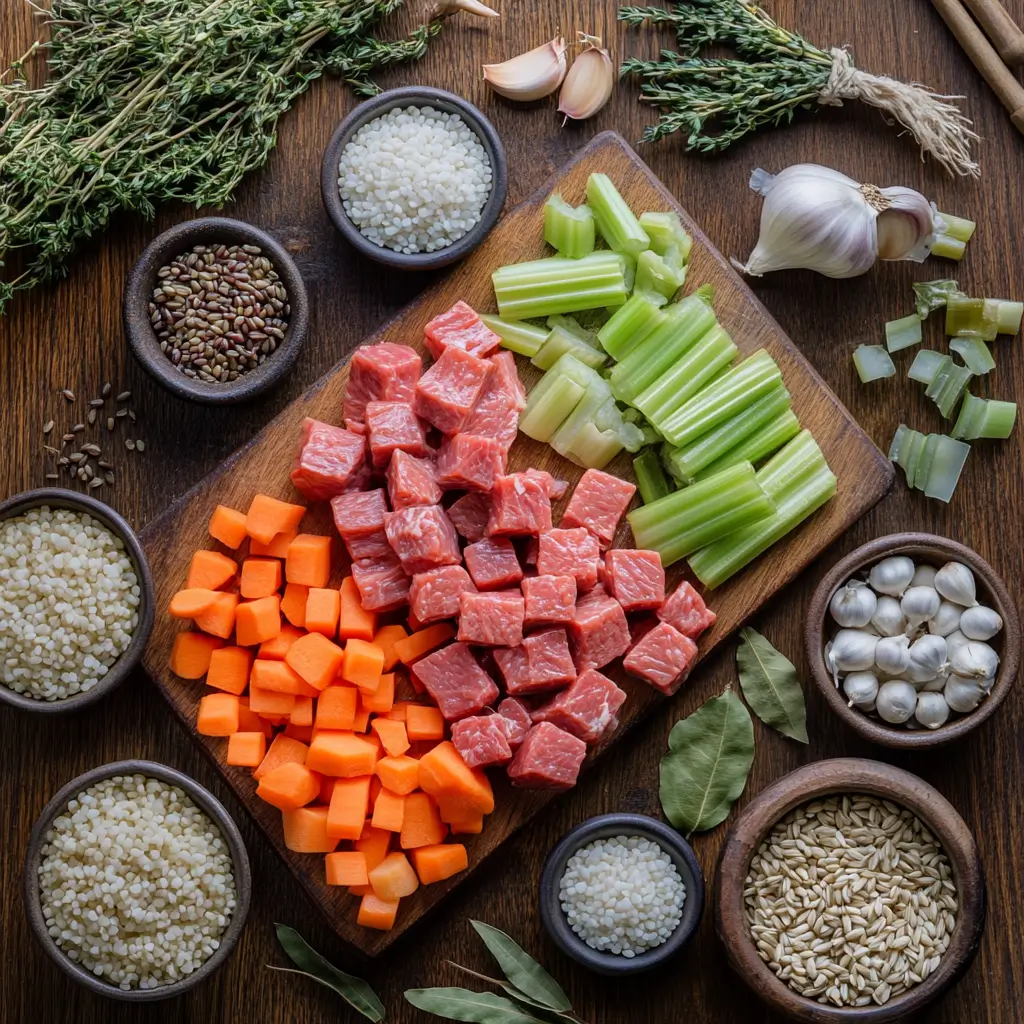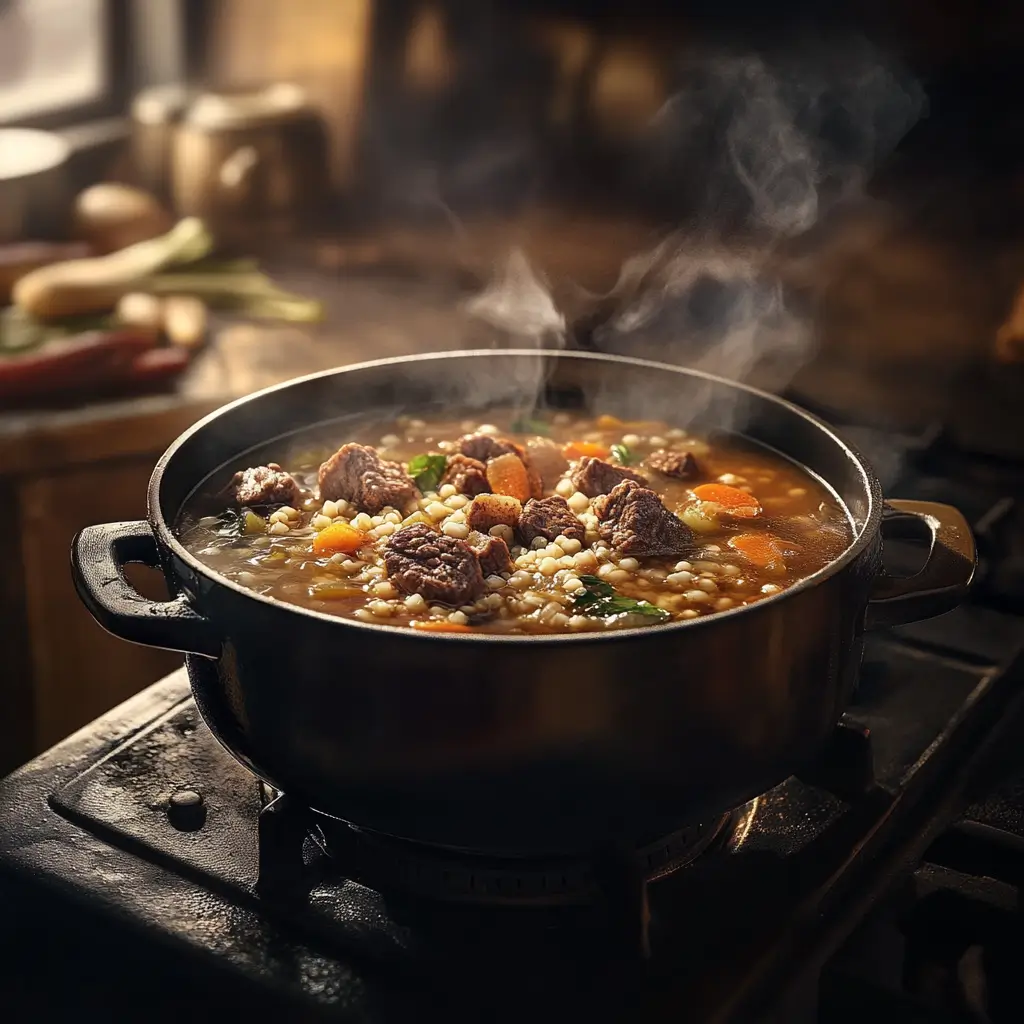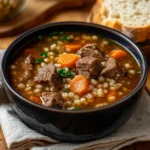There’s a reason why Beef and Barley Soup is a beloved dish in kitchens across America—it brings warmth, flavor, and comfort in every spoonful. Whether you’re trying to create a cozy dinner on a cold night or preparing a nourishing meal that can last for days, this hearty soup checks every box. It’s rich in texture, packed with nutrition, and simple enough for beginner cooks, yet satisfying for seasoned chefs alike.
At the same time, this isn’t just another soup—it’s a full meal in a bowl. The chewy barley, the tender beef, and the perfectly seasoned vegetables make it deeply satisfying. Furthermore, it’s easily customizable, affordable, and ideal for freezing and reheating. In fact, it’s just as handy for meal preppers as it is for busy parents or those learning to cook for the first time.
What Is Beef and Barley Soup and Why Is It So Popular?
To begin with, Beef and Barley Soup is more than just a soup—it’s a classic, old-world comfort dish that’s been handed down for generations. It combines affordable, accessible ingredients with slow cooking, which transforms tough cuts of beef into tender bites and bland grains into flavorful gems. Not only does this soup satisfy hunger, but it also warms the soul with every bowl.
In many households, this Beef and Barley Soup is a seasonal staple, especially in fall and winter. That’s because the beef provides protein and iron, while barley adds heart-healthy fiber and nutrients like selenium and B vitamins. Additionally, the vegetables add vitamins, color, and balance, making the dish as nutritious as it is comforting.
Moreover, this soup is especially versatile. You can add mushrooms, peas, parsnips, or even sweet potatoes depending on what’s in your fridge. For example, some families prepare it on Sunday and stretch it across multiple meals during the week. The flavors deepen overnight, which makes leftovers taste even better.
Another key point is its resemblance to other globally inspired grain-based dishes. In fact, its rich layering of flavors is similar to those found in street corn fusion bowls, where texture and balance are everything.
Overall, it’s the kind of meal you can rely on. Whether you’re making it from scratch on a slow Sunday or throwing together ingredients after work, it never fails to hit the spot.

Ingredients and Instructions for Classic Beef and Barley Soup
In truth, the beauty of Beef and Barley Soup lies in its simplicity. You don’t need fancy equipment or hard-to-find ingredients. All you need is a big pot, some patience, and a bit of love. Once the base is set, the rest is all about layering flavors and letting time do the work.
Ingredients Table
| Ingredient | Amount | Notes |
|---|---|---|
| Chuck roast (cubed) | 1.5 lbs | Substitute with stew beef or short ribs |
| Pearl barley | 3/4 cup | Rinse before use to reduce starch |
| Carrots (sliced) | 2 medium | Adds sweetness and color |
| Celery (chopped) | 2 stalks | Provides crunch and aroma |
| Onion (diced) | 1 large | Yellow or white onions work best |
| Garlic (minced) | 3 cloves | Fresh garlic for best flavor |
| Bay leaf | 1 | Remove before serving |
| Beef broth | 6 cups | Use low-sodium for better control |
| Olive oil | 2 tbsp | For browning meat and veggies |
| Salt & pepper | To taste | Adjust based on broth used |
| Fresh thyme | 1 tsp | Optional but adds depth |
Step-by-Step Instructions
1. Brown the Beef
To start, heat olive oil in a large pot over medium-high heat. Add the beef cubes in small batches. Then, sear each side until browned. Avoid overcrowding the pan to ensure a golden crust. Afterwards, remove the beef and set aside.
2. Sauté Aromatics
Next, reduce the heat slightly. Add onions, carrots, celery, and garlic to the same pot. Stir frequently until vegetables soften and release aroma. This usually takes about 6 to 8 minutes.
3. Deglaze and Combine
After the veggies soften, return the beef to the pot. Then, pour in the beef broth and scrape the bottom of the pot to release browned bits. Add barley, thyme, salt, pepper, and the bay leaf.
4. Simmer Slowly
Bring the soup to a gentle boil. Then, reduce heat, cover, and simmer for 60–90 minutes. Stir occasionally. When the beef is fork-tender and the barley is plump, the soup is ready.
5. Finish and Serve
Finally, remove the bay leaf. Taste and adjust seasoning. You may also stir in fresh parsley or a drizzle of olive oil for extra richness. Serve hot with crusty bread or a fresh green salad.

How to Master The Beef and Barley Soup
Once the Beef and Barley Soup has reached a steady simmer, your kitchen will likely fill with the warm, savory aroma of slowly braised beef and herbs. This stage is essential, because the next 30 to 45 minutes allow the barley to absorb the broth, the vegetables to soften perfectly, and the beef to break down into melt-in-your-mouth tenderness.
Moreover, stirring occasionally prevents sticking, especially toward the end when barley expands and thickens the soup. By this time, the rich color of the broth deepens, while the fat from the beef renders beautifully, creating a silky texture that coats the spoon.
Additionally, you might notice a layer of froth or fat rising to the surface. Skim this off gently with a ladle, but don’t remove too much, since it adds essential body and richness to the final bowl.
Finishing Touches to Elevate the Dish
At this point, you can add final touches that elevate the dish from homemade to restaurant-worthy. For instance, a small splash of lemon juice adds brightness and balance. Similarly, a pat of butter stirred in right before serving gives the soup a glossy finish.
As a matter of fact, some home cooks even drizzle a little olive oil infused with garlic or rosemary on top of the served bowl. These finishing oils enhance aroma and bring gourmet flair to a traditional soup.
After that, serve the Beef and Barley Soup hot, preferably with crusty bread, garlic toast, or even grilled cheese sandwiches. The soup’s rich base pairs especially well with a sharp cheddar or a tangy sourdough.
Storage and Reheating Tips
Later, once cooled, store leftovers in airtight containers. It’s best to divide the Beef and Barley Soup into single-serving portions for quick meals throughout the week. Since barley continues to absorb liquid, add a bit of water or broth when reheating to return the soup to its original consistency.
Freezing is also an option. However, it’s better to freeze the soup without barley and add freshly cooked barley when reheating. That’s because frozen barley can turn mushy and overly soft upon thawing.
Pro Tips & Variations for Perfect Beef and Barley Soup
Although the classic version is hearty and flavorful, you can easily tweak [Beef and Barley Soup] to suit different preferences or dietary needs. In fact, experimenting with variations keeps the dish interesting and lets you cater to seasonal ingredients or what you have in your pantry.
Vegetable Boosts and Seasonal Add-Ins
Additionally, try enhancing the soup’s nutrition and flavor with extra vegetables. For instance, diced sweet potatoes, parsnips, kale, or even green beans can add vibrant color and unique textures.
Especially during summer, substitute traditional carrots and celery with zucchini or corn kernels for a lighter twist. Surprisingly, roasted corn adds a sweet-smoky profile similar to what you find in modern street corn bowls, giving the soup a fresh spin. For those exploring hearty vegetarian alternatives, try a flavorful Coconut Stew with Spinach and Beans—it offers the same comfort and warmth with a rich, creamy coconut base and protein-packed legumes that pair beautifully with seasonal vegetables.
Regional and International Flavors
Alternatively, introduce global flair. For example, Middle Eastern-style versions might use cinnamon, allspice, and chickpeas, while Italian variants often include a tomato base and sprinkle grated Parmesan over each bowl.
As a result, you can adapt [Beef and Barley Soup] into a fusion dish using flavors from your favorite cuisine. Add miso paste for umami depth, gochujang for heat, or coconut milk for a creamy Southeast Asian version.
Slow Cooker and Instant Pot Variations
If you’re short on time or want a hands-off method, slow cookers and Instant Pots are excellent options. Simply brown the beef (if desired), add all ingredients, and cook on low for 7–8 hours in a slow cooker. For an Instant Pot, pressure cook for 30–35 minutes, then release naturally.
This approach ensures tenderness and flavor development without constant attention. Moreover, it’s ideal for busy weeknights or when batch cooking multiple meals.
What Spices Go in Beef Barley Soup for Ultimate Flavor?
While the base ingredients provide substance, it’s the spices and herbs that bring [Beef and Barley Soup] to life. Surprisingly, it doesn’t take a complicated spice blend—just the right combination of classics.
Bay leaf, thyme, and black pepper form the essential backbone. These offer earthiness and warmth without overpowering the soup’s natural flavors. Also, paprika or smoked paprika adds subtle sweetness and a hint of color, which gives the soup visual appeal and a more complex aroma.
Importantly, sautéed onions and garlic serve as the aromatic core. You can elevate these further with a splash of Worcestershire sauce, which introduces a slightly tangy, umami layer. Likewise, a small dash of soy sauce, if you’re out of Worcestershire, offers a similar effect.
For example, one memorable winter, I added a teaspoon of balsamic vinegar at the end of simmering. Surprisingly, it added a brightness that balanced the richness beautifully. Therefore, don’t hesitate to experiment with small amounts of acidity or umami-rich condiments.
Furthermore, finishing the soup with fresh parsley or rosemary adds freshness. As a result, the dish feels lighter on the palate, even though it’s hearty. Just remember, less is more—over-seasoning can mask the natural richness of the beef and barley.
Best Cut of Beef for Beef and Barley Soup
When making [Beef and Barley Soup], the beef you choose makes a huge difference. Although you can use almost any cut, chuck roast consistently delivers the best results. That’s because it contains enough fat and connective tissue to become juicy and tender during long simmering.
Additionally, stew meat is a great option if you want something pre-cut and easy to handle. For an even richer taste, bone-in short ribs add a deep, meaty flavor that enhances the broth. Conversely, lean cuts like sirloin may become dry or chewy, even if you cook them low and slow.
To illustrate, imagine browning cubes of chuck roast in a heavy Dutch oven. The smell of sizzling beef with a hint of seared edges fills the air. As I have noted in countless home-cooked batches, this caramelization step builds flavor that no store-bought soup can match. Furthermore, it infuses the broth with savory richness.
Another key point is to avoid skipping this browning step. While it might be tempting to toss everything in the pot at once, browning your beef separately, then deglazing the pot with broth or wine, adds unmatched depth.
Should You Cook Barley Before Adding It to Soup?
This question comes up often—and the answer is no, you typically don’t need to cook barley first. Instead, you should add it uncooked directly into the simmering broth. That’s because barley expands and softens beautifully as it absorbs the soup’s flavors. Consequently, it becomes tender, plump, and flavorful—never mushy.
However, there are exceptions. For instance, if you’re using quick-cooking barley, it may overcook if simmered too long. In that case, cook it separately and stir it in at the end. Additionally, some cooks prefer pre-cooking barley when they want a firmer bite or need to shorten the overall cook time.
Equally important, consider your storage plans. If you’re making a large batch to freeze, keep the barley separate. That’s because barley continues to absorb liquid as it sits, often turning the soup too thick upon reheating.
In essence, there’s flexibility here. While traditional recipes favor cooking barley within the soup, modern meal-preppers often adapt based on storage needs. As a tip, rinsing the barley before adding it also removes excess starch and prevents cloudiness.
To sum up, whether you cook it in the pot or separately, just monitor texture and timing. That way, the barley complements the soup rather than overpowering it.
FAQs About Beef and Barley Soup
What is the best cut of beef for beef and barley soup?
Certainly, the top choice is chuck roast. That’s because it has a perfect balance of fat and connective tissue, which breaks down into tender, flavorful meat. Additionally, stew meat or short ribs offer excellent alternatives for rich broth and succulent texture.
What spices go in beef barley soup?
Traditionally, bay leaves, thyme, black pepper, and garlic are the foundation. However, you can enhance complexity with rosemary, paprika, or a splash of Worcestershire sauce. Each spice contributes depth without overpowering the main ingredients.
Should I cook barley before adding it to soup?
No, it’s best to cook barley directly in the soup. That way, it absorbs the surrounding broth and flavor. However, if you prefer firm barley or need to freeze the soup, pre-cooking separately is a smarter option.
Is beef and barley soup good for you?
Yes, it’s a balanced meal in a bowl. Barley is high in fiber and supports digestion, while beef supplies essential protein and iron. Coupled with veggies, this soup nourishes both body and soul.
Can you freeze beef and barley soup?
Yes, but freezing it without barley yields better results. When barley sits in liquid too long, especially after freezing, it turns mushy. So, store it separately and combine upon reheating.
How long does it last in the fridge?
Generally, this soup lasts up to four days when stored in airtight containers. For best results, let it cool completely before refrigerating, and reheat over medium heat with a splash of broth.
Can I make it vegetarian?
Absolutely! Replace the beef with mushrooms, lentils, or chickpeas. Use vegetable broth instead of beef broth. As a result, you’ll enjoy a rich, filling soup that’s plant-based and packed with flavor.
What’s the difference between pearl and hulled barley?
Pearl barley is polished and softer, making it faster to cook and perfect for soups. In contrast, hulled barley is less processed, chewier, and more nutrient-dense but takes longer to soften.
Can I make this in an Instant Pot?
Yes! Use the sauté function to brown meat, then add remaining ingredients. Pressure cook for 30–35 minutes and let it naturally release pressure. The result is a deeply flavored soup in a fraction of the time.
Conclusion : Beef and Barley Soup
To summarize, [Beef and Barley Soup] is more than a recipe—it’s a culinary tradition that brings comfort, flavor, and nutrition to any table. With tender beef, toothsome barley, and a medley of vegetables, it delivers warmth in every bite.
Equally important, this soup is forgiving and versatile. Whether you stick to the classic or get creative with spices, grains, or veggies, you’re bound to end up with something delicious.
So, gather your ingredients, fire up your stove, and let this timeless dish fill your kitchen—and your heart—with its rich aroma and hearty goodness.
Table of Contents

Beef and Barley Soup : The Best Cozy Meal You’ll Truly Love
- Total Time: 90 minutes
- Yield: About 6 servings
Description
This Classic Beef and Barley Soup is the ultimate comfort food — hearty, flavorful, and incredibly satisfying. With tender chunks of beef, wholesome pearl barley, and aromatic vegetables, this soup is a cold-weather favorite that’s both nutritious and deeply comforting. Its secret? Simple ingredients, slow simmering, and lots of love. Perfect for cozy nights or make-ahead lunches!
Ingredients
1.5 lbs chuck roast, cubed (substitute with stew beef or short ribs)
3/4 cup pearl barley, rinsed
2 medium carrots, sliced
2 stalks celery, chopped
1 large onion, diced (yellow or white)
3 cloves garlic, minced
1 bay leaf (remove before serving)
6 cups beef broth (use low-sodium for better control)
2 tbsp olive oil
Salt & pepper, to taste
1 tsp fresh thyme (optional, adds depth)
Instructions
Brown the Beef:
Heat olive oil in a large pot over medium-high heat. Add the beef cubes in batches, searing each side until browned. Don’t overcrowd the pot. Remove browned beef and set aside.Sauté Aromatics:
Lower the heat slightly and add onions, carrots, celery, and garlic. Cook for 6–8 minutes, stirring frequently, until vegetables soften and become fragrant.Deglaze and Combine:
Return beef to the pot. Pour in beef broth and scrape the bottom to deglaze. Add rinsed barley, thyme, bay leaf, salt, and pepper.Simmer Slowly:
Bring to a gentle boil, then reduce heat to low. Cover and simmer for 60–90 minutes, stirring occasionally. Soup is ready when beef is fork-tender and barley is plump.
Finish and Serve:
Remove bay leaf. Taste and adjust seasoning. Garnish with fresh parsley or a drizzle of olive oil if desired. Serve hot with crusty bread or a green salad.
Notes
For extra richness, add a splash of red wine during the deglazing step.
Make it ahead: The soup tastes even better the next day as flavors deepen.
Store in the fridge for up to 4 days or freeze for up to 3 months.
If soup thickens too much upon standing, add a splash of broth or water when reheating.
- Prep Time: 15 minutes
- Cook Time: 75 minutes
- Category: Dessert
- Cuisine: American
Nutrition
- Calories: 390 per serving
- Fat: 16g
- Carbohydrates: 30g
- Protein: 28g
